Some issues experienced by J-109 owners are listed below but please note it is not comprehensive and there is no substitute for professional inspections and advice! Stuart Miller of SRM is an expert who can provide such advice.
-
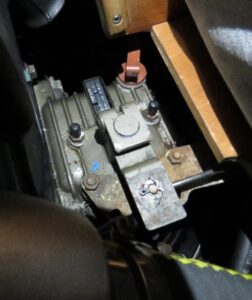 An obvious thing to check regularly is whether there are any oil leaks from the engine and for several years we had a few drips before we had the engine overhauled. Such leaks are obvious. Another important area with the potential for oil leaks is the gearbox. Oil from the engine is black and gathers in the sump if there is a leak. An oil leak from the gearbox is light, clean oil which makes its way into the bilge area in front of the sump and under the floor boards. You access the gearbox by removing the panel in the aft cabin. The dip stick is on the top and unscrews. It is worth checking this regularly for two reasons. Firstly the ‘O’ ring seals on the oil sump can fail and when in use the gearbox is under pressure and the oil is sprayed out and you can seize the gearbox which is hugely expensive to replace. Secondly, the boats have a sail drive and this has mechanical seals on the shaft just forward of the propeller. These fail over time and you may see evidence of this with a creamy emulsion on the dipstick. If the water is left in the sail drive and gearbox, over time it can cause corrosion.
An obvious thing to check regularly is whether there are any oil leaks from the engine and for several years we had a few drips before we had the engine overhauled. Such leaks are obvious. Another important area with the potential for oil leaks is the gearbox. Oil from the engine is black and gathers in the sump if there is a leak. An oil leak from the gearbox is light, clean oil which makes its way into the bilge area in front of the sump and under the floor boards. You access the gearbox by removing the panel in the aft cabin. The dip stick is on the top and unscrews. It is worth checking this regularly for two reasons. Firstly the ‘O’ ring seals on the oil sump can fail and when in use the gearbox is under pressure and the oil is sprayed out and you can seize the gearbox which is hugely expensive to replace. Secondly, the boats have a sail drive and this has mechanical seals on the shaft just forward of the propeller. These fail over time and you may see evidence of this with a creamy emulsion on the dipstick. If the water is left in the sail drive and gearbox, over time it can cause corrosion.- The sacrificial anodes on the propeller need to be checked and replaced regularly, it is good to keep spares.
- As boats tend to launch their spinnakers through the forehatch, this can cause damage and a leaking hatch because the hatches are closed with the lines attached.
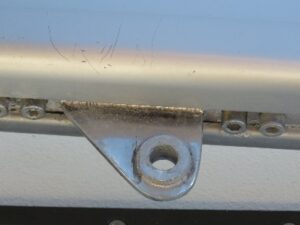 Where the kicker attaches to the underneath of the boom, the stainless of the kicker is bolted to an aluminium pad. The pads tend to corrode over time, owing to the different electromagnetic potential of the metals, leading to a failure. However, the boom can be repaired relatively easily when taken off.
Where the kicker attaches to the underneath of the boom, the stainless of the kicker is bolted to an aluminium pad. The pads tend to corrode over time, owing to the different electromagnetic potential of the metals, leading to a failure. However, the boom can be repaired relatively easily when taken off.- Where the sail drive comes through the boat, there is large doughnut shaped seal. Volvo Penta recommend these be changed every 7 years (I think). To do this you have to disconnect the engine and lift it up. Perhaps this is an opportunity to take the engine out and do some maintenance?
- The boats have rod rigging and we change ours approximately every 8 years.
- We had a crack in the sheave block at the top of the mast where the spinnaker halyards come out which required welding and the rig had to come out. It is worth having the rig taken out and inspected every few years.
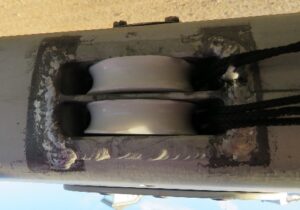
- We have had to replace the lower spreaders as the connections can cause wear in the spreader itself (the holes through which the pins fit). We had Ocean Rigging in Lymington make up new spreaders.
- The early boats were found to be a bit weak where the hull goes down to meet the keel in the area of the sump, by the table and were reinforced with layers of fibreglass and epoxy.. If you have hairline cracks that run along the top of the keel which we discovered a couple of years ago, it shows some flexing is taking place, so we had additional fibreglass layered inside the boat as a precaution. Keel inspection is now mandatory for class 2 racing such as the Fastnet and anytime you have a grounding it pays to have an inspection.
- Some boats have reported corrosion issues in the fuel tanks but others have not seen any evidence of this.
- You need to check the tension and the integrity of the guard rails on an annual basis as these can suffer wear and tear which can be hidden if you have foam coverings.
- Remember to keep gas appliances and hoses in date as hoses need to be replaced on a regular basis.
 A carbon based deposit tends to develop in the exhaust elbow which eventually reduces engine performance, To an extent you can remove it but you really need to replace it and if you have a stainless steel elbow fitted this is more resistant to deposition.
A carbon based deposit tends to develop in the exhaust elbow which eventually reduces engine performance, To an extent you can remove it but you really need to replace it and if you have a stainless steel elbow fitted this is more resistant to deposition.- The inside of the plate on the water pump tends to wear over time and can lead to a lack of ability for the system to hold water between engine uses with the water inlet sea cock open. It makes the engine difficult to start. You can close the seacock between uses and you can top it up. We were able to flip the cover round with the worn side out which gave us some extra use.
- Having a spare water pump impeller as well as a spare belt is a good idea (including the socket set to fit it)
- It is possible to break the spinnaker pole and it can take a long time to get a replacement as the boats are old. They are also expensive. One of the J-105 owners had Jason of Carrington Yachts make one in conjunction with Tricast composite tubes of Rochdale and was very satisfied with the price and the quality of the finish.
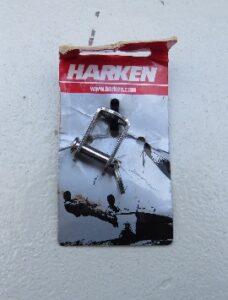 A weak point on the J-109 is where the main sheet attaches, it is worth carrying spares as it is not substantial. We have also found that the jib car blocks fail and it is worth carrying spares of these.
A weak point on the J-109 is where the main sheet attaches, it is worth carrying spares as it is not substantial. We have also found that the jib car blocks fail and it is worth carrying spares of these.- Some owners have had a boom gooseneck pin / ramshorns failure in strong winds. With the ramshorns snapping off from the gooseneck pin due to a failure of the weld. The actual pin part that attaches the boom to the mast was noticeably bent at the head of the pin and along the shaft too. The solution was to replace the pin with one made from stronger 17-4 stainless.
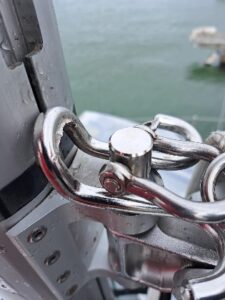
Please let us know if you can add to the list above. Again this is just a list of issues experienced by some of the boats and it is not meant to be comprehensive or represent expert advice on maintenance.
 An obvious thing to check regularly is whether there are any oil leaks from the engine and for several years we had a few drips before we had the engine overhauled. Such leaks are obvious. Another important area with the potential for oil leaks is the gearbox. Oil from the engine is black and gathers in the sump if there is a leak. An oil leak from the gearbox is light, clean oil which makes its way into the bilge area in front of the sump and under the floor boards. You access the gearbox by removing the panel in the aft cabin. The dip stick is on the top and unscrews. It is worth checking this regularly for two reasons. Firstly the ‘O’ ring seals on the oil sump can fail and when in use the gearbox is under pressure and the oil is sprayed out and you can seize the gearbox which is hugely expensive to replace. Secondly, the boats have a sail drive and this has mechanical seals on the shaft just forward of the propeller. These fail over time and you may see evidence of this with a creamy emulsion on the dipstick. If the water is left in the sail drive and gearbox, over time it can cause corrosion.
An obvious thing to check regularly is whether there are any oil leaks from the engine and for several years we had a few drips before we had the engine overhauled. Such leaks are obvious. Another important area with the potential for oil leaks is the gearbox. Oil from the engine is black and gathers in the sump if there is a leak. An oil leak from the gearbox is light, clean oil which makes its way into the bilge area in front of the sump and under the floor boards. You access the gearbox by removing the panel in the aft cabin. The dip stick is on the top and unscrews. It is worth checking this regularly for two reasons. Firstly the ‘O’ ring seals on the oil sump can fail and when in use the gearbox is under pressure and the oil is sprayed out and you can seize the gearbox which is hugely expensive to replace. Secondly, the boats have a sail drive and this has mechanical seals on the shaft just forward of the propeller. These fail over time and you may see evidence of this with a creamy emulsion on the dipstick. If the water is left in the sail drive and gearbox, over time it can cause corrosion. Where the kicker attaches to the underneath of the boom, the stainless of the kicker is bolted to an aluminium pad. The pads tend to corrode over time, owing to the different electromagnetic potential of the metals, leading to a failure. However, the boom can be repaired relatively easily when taken off.
Where the kicker attaches to the underneath of the boom, the stainless of the kicker is bolted to an aluminium pad. The pads tend to corrode over time, owing to the different electromagnetic potential of the metals, leading to a failure. However, the boom can be repaired relatively easily when taken off. A carbon based deposit tends to develop in the exhaust elbow which eventually reduces engine performance, To an extent you can remove it but you really need to replace it and if you have a stainless steel elbow fitted this is more resistant to deposition.
A carbon based deposit tends to develop in the exhaust elbow which eventually reduces engine performance, To an extent you can remove it but you really need to replace it and if you have a stainless steel elbow fitted this is more resistant to deposition. A weak point on the J-109 is where the main sheet attaches, it is worth carrying spares as it is not substantial. We have also found that the jib car blocks fail and it is worth carrying spares of these.
A weak point on the J-109 is where the main sheet attaches, it is worth carrying spares as it is not substantial. We have also found that the jib car blocks fail and it is worth carrying spares of these.